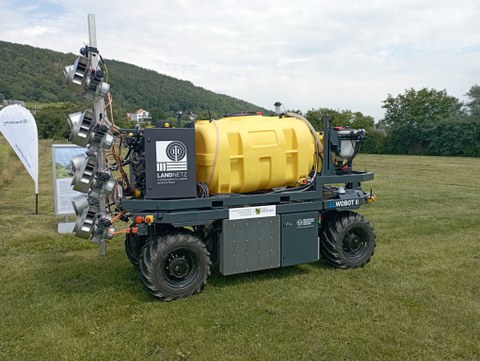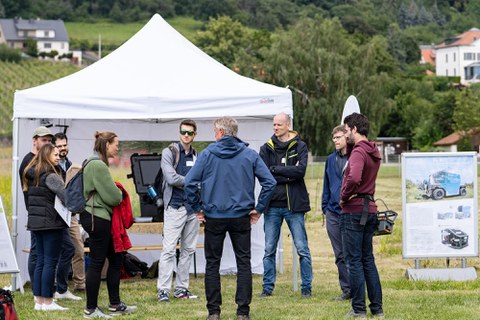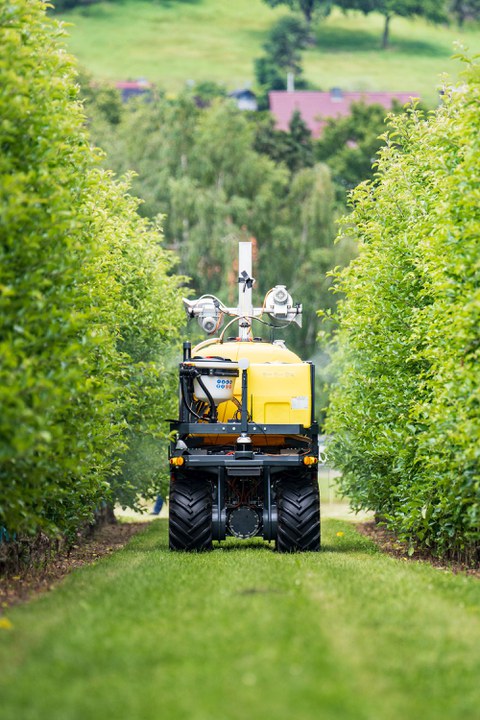Jun 14, 2024
Digitalization for a sustainable future in agriculture: Successful completion of the LANDNETZ collaborative project

elWObot II
Extreme weather events such as heat waves, cold snaps, droughts and heavy rainfall are increasing due to climate change, leading to significant crop losses and increasing challenges for farmers. With the help of digital technologies, processes in crop cultivation and livestock farming can be better monitored, controlled and optimized – from the health monitoring of dairy cows and digital herd protection to autonomous mechanical weed control. If we can use digitalization to optimize agricultural processes, for example by using modern technology to precisely control irrigation, nutrients and pesticides, we will need fewer resources. Agriculture can thus become more efficient and sustainable. However, the basic prerequisite for many of these digital applications is a stable and well-developed communications infrastructure, which is still lacking in many rural regions today.
Over the past five years, the LANDNETZ collaborative project, funded by the Federal Ministry of Food and Agriculture (BMEL), has been conducting research into extensive communication and cloud networks for the future of agriculture. To this end, a digital experimental field was set up in a model region in Saxony. Researchers from TU Dresden, the Fraunhofer Institute for Transportation and Infrastructure Systems IVI and staff of the Saxon State Ministry for the Environment, Agriculture and Geology (LfULG) tested various technologies for extensive wireless data transmission using 5G in rural areas and networked farms in the model region located northwest of Dresden. The test area is bordered to the north by the LfULG teaching and experimental farm in Köllitsch. Numerous partner operations are located further south in the Lommatzscher Pflege region, northwest of Meißen.
Since 2019, the Bundesnetzagentur has been providing frequencies for the operation of local 5G networks. This made it possible to create the new Mobile Campus Networks, a communications and cloud infrastructure designed to test and advance digital applications in the model region. Since then, stable 5G wireless connections were used to share data and directly network machines, robots and sensors – independent of public mobile networks.
“Ecologically and economically sustainable agriculture requires, among other things, targeted farming appropriate to the location. 5G supports precision farming of this type. In LANDNETZ, we investigated various options for this type of farming,” explained Prof. Thomas Herlitzius, speaker of the collaborative project. For example, to apply fertilizer to specific areas of a field as needed, a drone flies over an area of several acres and captures images of the crop with a multispectral camera. These are sent directly to the local server via 5G and processed there. These images are then used to determine how much fertilizer should be used. The fertilizer spreader, which is also integrated into the Campus Network, receives the values calculated by the data center and can immediately retrieve them for its current position in the field.
The use of smaller machines – equipped with sensors and artificial intelligence – that can autonomously perform complex operations such as pesticide application, as well as simple repetitive tasks, is another important step toward combining sustainability with economic efficiency.
The electric modular robot elWObot II for horticulture, fruit growing and viticulture is a self-propelled tool carrier that can be used areas with restricted space such as orchards. With additional modules for mowing and mulching, for plant protection or for contour cutting, it can be used for a wide range of applications. The elWObot II can work precisely and on demand, supported by sensors. The robot is in constant communication with the local server and sends current data that is evaluated in the control center.
5G also forms the basis for networked mobility. The ON/OFF Road Safety sub-project was developed as part of the LANDNETZ project to make road traffic in rural areas safer. Scientists are working on communication infrastructures and information systems that will allow warning signals to be sent and received between individual vehicles as required. “As the level of automation increases, so do the safety requirements for highly automated agricultural equipment. The networking of machines with each other, with a monitoring dispatcher or with vehicles on the road via 5G mobile communications meets these requirements,” explains Prof. Matthias Klingner, Director of Fraunhofer IVI. In the model region equipped with 5G, the team designed and tested typical use cases, such as the collision of a large agricultural machine with a car or a motorcyclist. The ability of individual vehicles, vehicles and traffic infrastructure, or mobile agricultural machinery to spontaneously exchange information via vehicle-to-x communication can significantly improve road safety.
“The use of digital technologies in agriculture is not an end in itself,” said Heinz Bernd Bettig, President of the Saxon State Ministry for the Environment, Agriculture and Geology. “Instead, as part of the project, we focused on users' needs and investigated pioneering technologies to support the mounting challenges in agriculture.” As the collaborative project drew to a close, the latest developments were presented at the regional conference “Digital applications for agricultural practice” this Thursday.
Contact:
Dr. Isabel Raabe
TU Dresden
Tel.: +49 351 463 41024
Email: isabel.raabe@tu-dresden.de
Elke Sähn
Fraunhofer Institute for Transportation and Infrastructure Systems IVI
Tel.: +49 351 4640-612
Email: elke.saehn@ivi.fraunhofer.de
Karin Bernhardt
Saxon State Ministry for the Environment, Agriculture and Geology
Tel.: +49 351 2612 9002
Email: Karin.Bernhardt@smekul.sachsen.de



